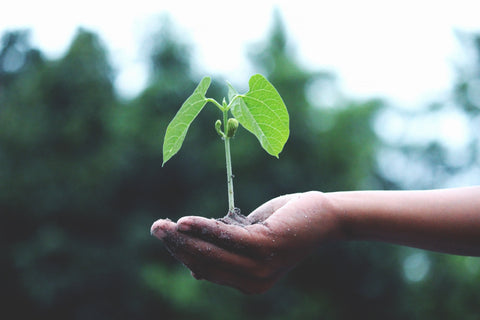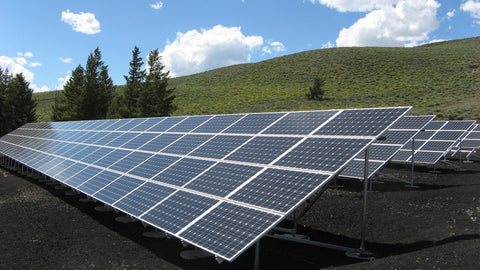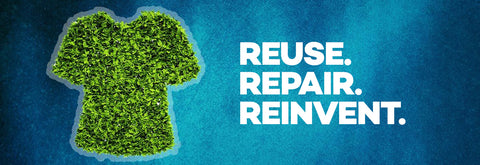It’s no secret that today, the world faces heightening political, social, economic and environmental crises that get worse with each passing day. Part of the reason why many of these issues still exist is due to inaction by previous governments and generations.
In 2015, the United Nations announced a list of 17 Sustainable Development Goals (SDGs) to be achieved by the year 2030. They are designed to be a blueprint of how we can create a better and more sustainable future for ourselves, and the world we inhabit.
While they are a call to action for governments across the world, it also provides plenty of scopes for individuals and organizations to contribute.
In a changing world that prepares itself to face new Problems and Consequences, the 17 SDGs give us an idea of how to navigate the world of tomorrow.
These are the 17 SDGs recommended by the United Nations.
Recommended Reading: The Extraordinary Growth of Organic Cotton
Goal 1: Eradication of Poverty
The UN aims to end extreme poverty around the world by the year 2030.

Problem and Consequences:
Poverty in developing and third world countries remains a major issue. 1 in 10 people around the world lives on less than $1.25 a day.
Children and pregnant women are most affected by poverty. Close to 400 million children are estimated to be living under $2 a day. This can seriously affect their education, health, and security.
Solutions and challenges:
Creating more jobs, increasing the minimum wage, and providing free and affordable healthcare services lessen the impact of poverty.
However, it faces major challenges such as poor economic growth, inequality, and climate change.
Goal 2: Zero Hunger
The UN aims to end global hunger, promote sustainable agricultural practices, and improve food security and nutrition.

Problem and Consequences: Hunger and malnutrition are intrinsically linked with poverty.
1 in 9 people around the world are undernourished, most of them from developing countries. It is responsible for the deaths of 3 million children under the age of 5, every year.
Solutions and Challenges: By increasing agricultural productivity, ensuring sustainable food production chains, increasing access to land, and preventing trade barriers to reduce price, malnutrition rates will substantially reduce.
However, economic inequality and social discrimination are major barriers to this end.
Goal 3: Good Health and Well-Being for People
Ensuring that everyone can lead a healthy life and that overall physical and mental well-being is promoted for all ages.

Problem and Consequences:
While life expectancy rates have shot up and mortality rates have gone down, there’s still a looming public health crisis. While smallpox and polio have almost been completely eradicated, the outbreak of diseases such as Ebola and H1N1 have terrorized public imagination.
Diseases such as tuberculosis, malaria, and HIV spread rampantly. Mortality rates and deaths during labor also shoot up. Poor sanitation and hygiene also reduce immunity. Poor family planning can further worsen the effects of overpopulation.
Solutions and Challenges:
SDG3 aims to reduce maternal mortality rates to less than 700 per million live births. It also seeks to ensure that progress is made to make clean water and sanitary conditions accessible to all. Universal health coverage, which includes easy access to medicines and vaccines are also covered under it.
However, progress has been slow and insufficient data prevents us from getting a complete view of the picture today.
Goal 4: Quality Education
Ensuring that inclusive, equitable, and lifelong quality education and learning opportunities are afforded to one and all.

Problem and Consequences:
While access to education is no longer a major problem, there remain lingering questions over the quality of the education imparted.
Although major progress has been in this field in the last century, 103 million children (mostly girls) are still illiterate. At least 22 million children miss out on pre-primary education every year.
The biggest threats to the completion of education are poverty, social inequality, and malnutrition.
Solutions and Challenges:
Making education up to the secondary level mandatory has increased school attendance rates. Free mid-day meals are a valuable incentive for disadvantaged students.
While progress is made every year, it is difficult to track due to a lack of reliable data.
Goal 5: Gender Equality
Enshrining gender equality and empowering all women and girls.

Problem and Consequences:
Gender equality is viewed as a fundamental human right, as well as a precursor to peace, prosperity and sustainable development. However, patriarchy and sexism are woven in the cultural and social fabrics of many countries. This translates into fewer opportunities for women.
While women’s rights have improved over the world, patriarchy remains a Problem and Consequences. Practices such as gender discrimination, child marriage, female genital mutilation remain serious issues, particularly in developing countries.
Solutions and Challenges:
Fulfilling gender equality requires legislation that promotes the empowerment of women, the abolition of sexist practices, and greater representation in all walks of life.
While measurable progress is made around the world, it is still slow. Women continue to be oppressed and consigned to traditional roles.
Goal 6: Clean Water and Sanitation
Ensuring the availability and sustainable management of clean water and sanitation to all.

Problem and Consequences:
Lack of access to clean water for drinking purposes and sanitation is one of the biggest vectors of disease in the world. Worldwide, 6 in 10 people lack safe sanitation systems. 3 out of 10 lack access to safe water services.
Solutions and Challenges:
The first step is the eradication of open defecation. More toilets need to be constructed in areas without access to one. But this requires a change in attitudes as well as proper implementation.
Many third world countries are notorious for a reluctance to adopt toilets despite their availability.
Bonus Tip: How Sustainable is Your Product?
Goal 7: Affordable and Clean Energy
Ensuring access to clean, reliable, affordable, and sustainable energy for all.

Problem and Consequences:
Fossil fuels are responsible for the degradation of the ozone layer and much of climate change. To halt the rise in global temperatures, it is necessary to take to sources of renewable energy.
Solutions and Challenges:
This would involve the adoption of alternative sources of energy such as wind and solar energy. Vehicles need to be tested for emissions and electric vehicles should gradually be phased in.
However, many sources of renewable energy are prohibitively expensive. Developing nations are still heavily reliant on coal and other fossil fuels. Electric vehicles are still a long way from becoming mainstream. Only 57% of the world relies on clean fuels, well short of the targeted 95%.
Goal 8: Decent work and Economic Growth
Promoting inclusive and sustainable economic growth, as well as full and productive employment to all.

Problem and Consequences:
Economic inequality contributes to poverty, unemployment, and low economic growth. These factors can increase crime rates and threaten security.
Unless there are balanced economic policies that account for all sectors of society, long term economic growth will be impossible.
Solutions and Challenges:
Governmental investment and encouragement in new technologies and trends will encourage entrepreneurs and SMEs. Relaxing trade and foreign investment laws can also boost the economy while encouraging the tourism sector is the best way to bring about a prosperous economy.
However, the overhaul of present economic systems is still a distant dream. The fact that governments are usually funded by the upper echelons of society means that they may be reluctant to change the system.
Goal 9: Industry, Innovation, and Infrastructure
Building resilient infrastructure, and promotion of inclusive, sustainable industrialization, while fostering innovation.

Problem and Consequences:
The manufacturing sector is a vital source of employment and economic growth. However, it is underutilized in developing countries.
Manufacturing value added per capita in the USA comes up to $4621, while in less developed countries, it is a meager $100.
Solutions and Challenges:
Greater attention needs to be directed to the manufacturing sector. An Internet connection and accessibility need to be provided to all at affordable rates. This increases connectivity and coverage.
As of today, nearly 95% of the population has access to cellular signal coverage.
Goal 10: Reduction of Inequality
Reducing income inequality within and among countries.

Problem and Consequences: The 1% and 99% is a well-known analogy, to sum up, income inequality. The fact that a small minority hoard as much wealth as the overwhelming majority of the population is responsible for poverty and social inequality at large.
Solutions and Challenges:
The UN aims to achieve this by sustaining the income growth of the bottom 40% at a rate higher than the national average. It also plans to achieve this by reducing the transaction costs of migrant remittances to below 3%.
However, it is still a long way from being achieved. Remittance charges are between 6-11% in many money transfers and banks. It remains difficult to bring long-lasting economic changes due to resistance from the upper strata of society.
Goal 11: Sustainable Cities and Communities
Making cities and settlements safe, resilient and models in sustainability.

Problem and Consequences:
Many cities around the world, including major ones, are designed in a haphazard manner. Rent and prices are also on the rise, making daily life unaffordable to the average person.
Solutions and Challenges:
Making housing cheaper and more affordable for all encourages migration and settlement from rural areas. The abolition of slums is necessary as they can be breeding grounds for diseases.
However, while the percentage of people living in informal settlements has fallen, the absolute number of such people has increased.
Also Read: Why Should You Recycle?
Goal 12: Responsible Consumption and Production
Ensuring consumption and production patterns follow the principles of sustainability.

Problem and Consequences:
Unhealthy consumption habits and overpopulation have led to an enormous amount of waste. These wastes can hamper efforts to save the environment, as they may be toxic or non-biodegradable. This can cause air, water and soil pollution while threatening the bio-systems that depend on it.
Solutions and Challenges:
Encouraging eco-friendly production methods and recycling can reduce the amount of waste present. Companies should also start sustainable practices and products, and produce sustainability reports.
While progress is steady on the awareness front, acceptance remains slow.
Goal 13: Climate Action
Taking action to combat climate change and its impact by regulating emissions and promoting renewable energy.

Problem and Consequences:
Climate change is the largest threat we may have to face as a species. It has melted glaciers, raised temperatures, killed off ecosystems, and shows signs of irreversibility. It is also indirectly linked to socio-economic problems such as poverty, gender inequality, and energy.
Humanity as we know it may not exist in the distant future if we do not deal with climate change urgently.
Solutions and Challenges:
Reducing the amount of emissions released in the atmosphere by adopting renewable sources of energy. Recycling needs to become the norm, and not the exception. Petrol, coal, and fossil fuels need to give way to electrical and solar energy. Single-use plastics need to be outlawed. The planting of trees and reforestation of jungles may help avoid the catastrophic consequences of climate change.
However, governments all around the world are guilty of not taking it seriously enough. As things stand, a colossal effort is required by all of us to turn back the effects of climate change.
Goal 14: Life below Water
Conserving and using the ocean, seas and marine resources for sustainability.

Problem and Consequences:
Thanks to pollution and climate change, marine life is under severe threat. Plastic wastes thrown in the ocean suffocate aquatic species, while extensive fishing has endangered several species. Coral reefs are dying out, and marine eutrophication and acidification have further exacerbated the problem.
This is a severe problem as oceans cover 71% of the Earth’s surface. Half the global population depends on them for their livelihood. The oceans regulate rainwater, drinking water, and climate as well.
Solutions and Challenges:
Individuals can help by avoiding plastics. Nations such as Norway have already made progress by encouraging citizens to participate in clean-up drives. Keeping beaches and the ocean clean can also promote tourism.
However, progress made been slow. The data on ocean pollution rates still paint a bleak picture.
Goal 15: Life on Land
Protecting, restoring and promoting sustainable use of ecosystems, being sustainable in the use of forests, and halting desertification, reversing land degradation, and biodiversity loss.

Problems and Consequences:
Extensive deforestation and human activities have threatened several terrestrial species. Many of them have lost their natural habitats, forcing them to go extinct. Hunting for the game has also killed off several species of animals.
These changes can adversely affect the food chain and inadvertently threaten the survival of other species.
Solutions and Challenges:
Much of degraded land can be reforested by planting trees. Preventing the growth of invasive species can help endangered ones thrive. It is also necessary that illegal mining, deforestation, and land clearing are strictly enforced punishable offenses.
The sad truth is despite the grim reality of our forests, deforestation continues to be rife. Forests are cleared off for grazing land. A large portion of the Amazon rainforest was lost due to fires started for the same reason just two months ago.
Goal 16: Peace, Justice and Strong Institutions
Promoting peaceful and inclusive societies for sustainability, providing access to justice for all, and building effective, accountable and inclusive institutions at all levels.

Problems and Consequences:
Violent crime, forced labor, sex trafficking, and child abuse are some of the biggest social problems we face today. 84% of victims of violent crime are women, and the perpetrators are almost always men. While sexual exploitation figures have come down, those of forced labor is on the rise.
Solutions and Challenges:
Stricter enforcement and penalties directly affect the rates of such crimes. However, since many of these crimes remain unreported, it is difficult to ascertain their extent.
Goal 17: Partnership for the goals
Strengthening the implementation of these goals and revitalization of the global partnership for sustainability and development.

Problems and Consequences:
Without international cooperation and support, it is unlikely that any of these goals will be fulfilled. The country must cooperate with civilians and the private sector with the public.
Solutions and Challenges:
In today’s hostile political climate, trade and migratory barriers are higher than ever. Internationalism is slowly but surely replaced by nationalism all around the world. This makes cooperation and collaboration more difficult than it already is.
Recommended Reading: Why Sustainable Fashion Matters?
How NorthMist abides by the SDGs
NorthMist as an organization was born after recognizing the urgent need to make sustainability a part of our lives. The core tenet of our business philosophy is a concern for the environment and being sustainable.
While we’re one of the very few organizations in India that sell t-shirts made out of GOTS certified organic cotton, our attempts to save the environment don’t stop there.
Also Read: Everything You Need to Know About GOTS Certification

Our products are made entirely out of recyclable and biodegradable materials. This extends towards our packaging and tags as well. Whether you choose to dispose it or keep it, we’ve designed them in a way that leaves a minimal footprint on the environment.
Bonus Tip: How is NorthMist Packaging Different?
Sustainability goes beyond the product and its packaging as well. If organizations do not practice sustainable manufacturing processes, they fail to live up to their claims.
At NorthMist, we ensure that no inorganic chemicals or toxic dyes are used while manufacturing our products. This ensures that local water bodies are unpolluted by our activities. It also guarantees our workers a safe work environment.

With respect to the SDGs regarding worker and employee rights, those who work for us are paid more than the minimum wage required by law. Work hours are strictly regulated. We ensure that they are treated in a fair, just, and ethical manner and that they can voice out their concerns without fear of retribution.
At NorthMist, our bottom-line is just one part of the equation and not the end of it. We understand that irresponsible corporate behavior is to blame for much of the problems the UN tries to tackle with the SDGs.
We truly believe that our efforts, no matter how insignificant, will go a long way in the battle to save the environment.
Interested in learning more about us? Visit our website to know how you can be a part of our journey.
If you found this post informative, we’re sure you’ll love our blog.





